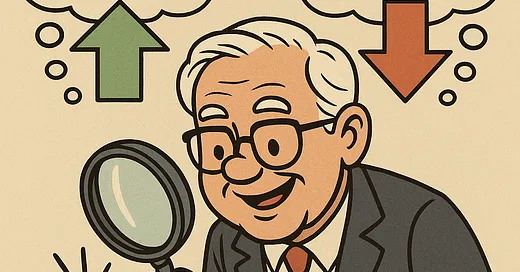At Relax to Rich, we focus on long-term wealth through simple principles and smart metrics. One of the smartest? Return on Equity (ROE)—Buffett’s favorite.
Warren Buffett once said,
“If I could pick only one metric to evaluate a company, I’d choose return on equity (ROE).”
🧮 What is ROE?
ROE = Net Profit ÷ Shareholders’ Equity
It measures how efficiently a company turns shareholder capital into profits. In practice, we usually calculate it using net income attributable to common shareholders and average equity over time.
Here’s the mental shortcut:
If shareholders were one person, ROE tells you whether this “person” is getting richer from the business they own.
A high ROE is like playing poker with house money and better odds—it doesn’t guarantee a win, but it sure tilts the table in your favor.
💼 Why Book Value Isn’t Always Meaningful
For non-financial companies like Apple, Visa, or Nike, book value often underrepresents reality. Their true strength lies in intangibles—brand power, network effects, or software that doesn’t show up on the balance sheet.
But financial giants like JPMorgan Chase or Bank of America? That’s a different story. Their balance sheets matter more because their assets are marked to market under strict regulations.
So here’s the paradox:
If book value isn’t that useful, why should we care about ROE, which uses book value in the denominator?
The answer lies in how you use ROE correctly.
💡 The Fisher Insight
In The Theory of Interest (1930), economist Irving Fisher wrote:
“Any resource that can generate future income is capital. Capital is the present value of future returns.”
That simple line changes everything.
It explains:
- Why a barista in Manhattan earns more than one in rural Montana for the same work.
- Why a bottle of aged Pappy Van Winkle costs 20x more than a fresh bottle of Jim Beam.
- Why companies with similar assets show radically different profits.
Capital isn’t just money. It’s:
- Brand power (think Coca-Cola)
- Data (like Meta)
- Design (like Apple)
- Community trust (like Costco)
- Talent (like Netflix’s original content engine)
If your capital draws in customers and cash flow, it has value—even if accounting ignores it.
🔍 Using ROE the Right Way
When you see a high ROE, don’t stop there.
Ask: What’s creating this return that I can’t see on the balance sheet?
When you see low ROE, ask: Which assets are bloated, impaired, or overvalued but still listed as full value?
A Quick Example:
- Imagine building a toll booth in Times Square = massive ROE.
- Build that same booth in the middle of Death Valley = almost zero ROE.
Same cost. Same labor. But one is a gold mine. The other? A sunk cost.
Why?
Because Times Square comes with invisible capital—foot traffic, access, location rights.
The desert has none of that. It may even represent bad judgment, which also doesn’t show up on the balance sheet.
🧠 Charlie Munger’s Trick: Invert, Always Invert
“Invert, always invert.” – Charlie Munger
So flip the ROE equation:
- High ROE → What’s the hidden asset?
- Low ROE → What asset should’ve been written down but wasn’t?
Let’s compare:
- Coca-Cola: Modest physical assets, but huge profits. Why? Brand equity, scale, and distribution power—none of which are fully captured in the financials.
- A no-name soda company? Might have the same machines and staff, but no moat—hence low ROE.
Accounting calls this missing value “goodwill”, but only if it comes through acquisition.
If a company built that value organically—like Google or Tesla—its balance sheet shows $0 goodwill.
But we all know the real-world value is massive.
Buffett gets this. He once said:
“I especially like businesses with large, sustainable economic goodwill and little need for tangible assets… In inflationary times, economic goodwill is a gift that keeps on giving.”
That’s ROE done right.
🧭 What ROE Doesn’t Tell You
ROE is a first filter—not a final decision.
At Relax to Rich, we treat high ROE as a signal to go deeper.
You still need to ask:
- What’s the hidden asset driving those returns?
- Is it growing, stable, or shrinking?
- Does maintaining it require more capital? Is the ROI still attractive?
In short: Is it a moat, or just momentum?
🕳️ The Blind Spot: Comebacks
ROE is great for spotting today’s champions, but it often misses tomorrow’s breakout stars.
Buffett famously skipped Amazon for years. It reinvested everything and showed weak early ROE.
But its long-term competitive advantage—customer obsession and operational scale—wasn’t visible yet.
So yes, ROE helps you avoid duds.
But it might also blind you to the underdog stories that transform industries.
🧘 Final Take — Relax to Rich Style
At Relax to Rich, we don’t chase hype—we chase quality.
ROE is one of our favorite tools because it leads us to businesses that:
✅ Use capital wisely
✅ Have durable hidden strengths
✅ Don’t need constant reinvestment to grow
But we never stop at the number. We look behind it.
Because in the long run, the best investments aren’t just statistically smart—they’re strategically wise.

